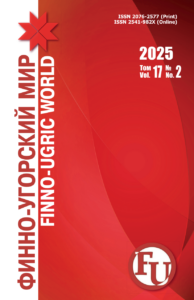DOI: 10.15507/2076-2577.012.2020.03.303-313
Khants-Mansi folk motives in the modern Yugorsk advertising: cultural and linguistic aspect
Margarita S. Vykhrystyuk,
Doctor of Philology, Professor, Department of Philological Education,
Tyumen State University
(Tyumen, Russia), margaritavv@mail.ru
Aleksandra A. Mironova,
Doctor of Philology, Professor,
Department of the Russian Language
and Methods of Teaching the Russian Language,
South Ural State Humanitarian Pedagogical University
(Chelyabinsk, Russia), amiron_rus@maul.ru
Tatyana V. Simashko,
Doctor of Philology, Professor,
Department of General and Germanic Linguistics,
Branch of the Northern (Arctic) Federal University named after M. V. Lomonosov
(Severodvinsk, Russia), simashkotv@yandex.ru
Introduction. The article analyses of extralinguistic factors that form the advertising trademarks of Ugra. Created emblems, product logos represent an original trade proposal, based on the culture and language of the Khanty and Mansi peoples. The aim of the paper is to determine the role of folk images, motives of the Khanty and Mansi in the process of creating modern trade marks for Ugra advertising. When analyzing logos, brands, symbols of Ugra brands, it is substantiated that one of the effective methods of influencing the audience is the appeal to folk culture, folk memory.
Materials and Methods. Advertisement texts were collected from Khanty-Mansiysk local printed media, Internet advertisement (VKontakte social media, Youtube) by the continuous sampling method. A total of 450 advertisements were analysed. The main research methods are descriptive, component analysis, as well as individual elements of comparative and contextual methods.
Results and Discussion. Background knowledge of the Khanty and Mansi peoples that were presented in the product’s trademark, stimulate the recipient’s mental process, activate autocommunication. Creolization in demonstrating the advantages of the Yugor brand allows a potential customer to complete the message by replenishing the details, thereby contributing to the promotion of goods in the consumer market. Nowadays the research in the Khanty language lack specialised research papers dedicated to folklore references in advertisement, there are only a few piecewise studies. On the other hand, the abundance of research in folklore studies, social studies, cultural studies and brand-building demonstrate the timelessness of the subject from the perspective of the linguistic manifestation of Khanty worldview in advertisement texts.
Conclusion. The material of the study reveals the people’s wealth and the effectiveness of Khanty and Mansi references in advertisement. Linguistic ethnical and cultural stereotypes construct a wideview on the subject and create a unique, individual trade proposal in other regions as well.
Key words: Yugor advertisement; ethno-labeled signs; colour naming; decorative pattern.
For citation: Vykhrystyuk MS, Mironova AA, Simashko TV. Khants-Mansi folk motives in the modern Yugorsk advertising: cultural and linguistic aspect. Finno-ugorskii mir = Finno-Ugric World. 2020; 12; 3: 303–313. (In Russian)






















